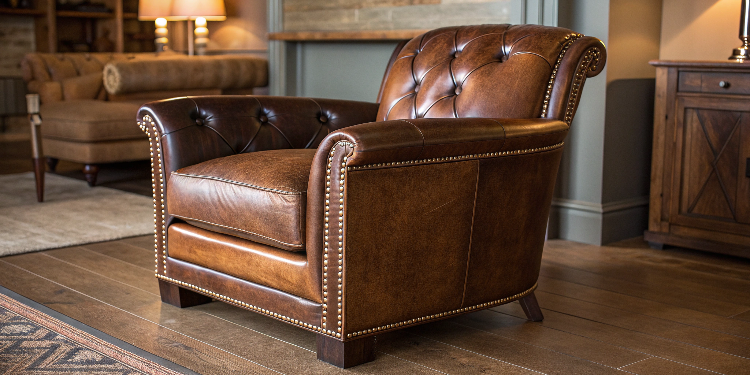Reclaiming Your Leather: A Definitive Guide to Removing Cigar Smoke Odor

By the Team at Commercial Air Purifiers
Published: October 12th, 2025
Leather furniture possesses a timeless appeal. It's luxurious, durable, and often the centerpiece of a well-appointed room. But when that rich, natural scent is overtaken by the stubborn, invasive odor of stale cigar smoke, it can be incredibly frustrating. What was once an inviting armchair or a handsome sofa becomes a source of unpleasantness, emitting a smell that seems to have permanently bonded with the material. You’ve tried airing it out, maybe even wiped it down, but the phantom scent of old smoke remains.
If you're struggling to reclaim your valuable leather goods from the ghost of cigars past, you've come to the right place. This guide will delve into the science of why cigar smoke is so persistent on leather, provide a methodical, step-by-step process for cleaning and deodorizing it safely, and, most importantly, show you how to prevent the problem from ever happening again.
Why Cigar Smell is So Stubborn on Leather
To defeat the enemy, you must first understand it. The lingering cigar odor is not just a smell; it's a physical residue known as thirdhand smoke (THS). This residue is composed of a complex and sticky mixture of chemicals from the cigar smoke, including tar, nicotine, and hundreds of other volatile organic compounds (VOCs).
The U.S. Centers for Disease Control and Prevention (CDC) describes this residue as a toxic cocktail that clings to surfaces long after the smoke has cleared. What makes it particularly problematic for leather is its oily, resinous nature. While high-quality, finished leather is far less porous than fabric, it is not invincible. The surface of the leather, with its microscopic pores and protective topcoat, can trap these tiny, oily particles. Over time, this residue can even begin to degrade the leather's finish, leading to discoloration and a sticky feel.
Different types of leather react differently:
-
Finished (or Pigmented) Leather: This is the most common type used for furniture. It has a polymer coating that provides protection, making it the most resistant to stains and smells. The smoke residue tends to sit on this top layer, making it the easiest to clean.
-
Aniline and Semi-Aniline Leather: These are dyed with soluble dyes without a heavy protective topcoat, giving them a very soft, natural feel. Unfortunately, this also makes them much more absorbent and susceptible to permanent smoke odor absorption.
-
Nubuck and Suede: These leathers have a napped, velvet-like surface and are extremely porous. They will absorb smoke odor very quickly and are exceptionally difficult to clean without professional help.
This guide will focus primarily on cleaning finished leather, as it is the most common and the most suitable for DIY methods.
The Remediation Process: A Methodical Approach to Odor Removal
Patience and a gentle hand are key to successfully treating your leather. Rushing the process or using harsh chemicals can cause irreparable damage. Before you begin, you must perform a spot test.
The Cardinal Rule: Assessment and Spot Testing
First, confirm your leather type. Place a single drop of water on an unseen part of the furniture (like underneath a cushion). If the water beads up, you have protected, finished leather. If it soaks in quickly and darkens the material, you likely have aniline or nubuck leather, and we strongly recommend consulting a professional leather specialist.
Next, spot test every single cleaning product you intend to use. Mix your cleaning solution and apply a small amount to another hidden area with a clean cloth. Let it sit for a few minutes, then wipe it dry and allow the area to air out completely. Check for any discoloration, staining, or damage to the finish before proceeding to clean the entire piece.
Step-by-Step Cleaning for Finished Leather
Once your spot test is successful, you can begin the main process.
Step 1: The Dry Prep - Thorough Vacuuming
Before introducing any moisture, you must remove all dry debris. Using a vacuum with a soft brush attachment, meticulously go over the entire piece of furniture. Pay close attention to the seams, crevices, and button tufts where ash and other particles love to hide. This prevents you from turning dry dust into mud during the wet cleaning phase.
Step 2: The Surface Decontamination - Cleaning the Residue
This step is designed to break down and lift the oily, sticky thirdhand smoke residue from the leather's surface. A simple yet effective solution is a 50/50 mixture of distilled water and plain white vinegar. The mild acetic acid in the vinegar is excellent at cutting through the oily film without being overly harsh.
-
Mix the solution in a small bowl.
-
Dip a clean, soft microfiber cloth into the solution and wring it out until it is just damp, not wet. Over-saturating the leather can cause damage.
-
Working in small, manageable sections, gently wipe down the surface of the leather.
-
Immediately follow up with a second clean microfiber cloth that is dampened with only distilled water to "rinse" away the vinegar solution.
-
Finally, use a third, completely dry microfiber cloth to buff the section dry.
-
Repeat this process until you have cleaned the entire piece of furniture.
Step 3: The Deodorizing Phase - Absorbing Lingering Odors
After cleaning, some odor molecules may still be trapped in the leather's pores. Your next step is to draw them out.
Generously sprinkle baking soda over the entire surface of the leather furniture. Baking soda is a fantastic natural deodorizer that will absorb residual odors. Let it sit for several hours, or even overnight if the smell is particularly strong. Afterward, use your vacuum's soft brush attachment to carefully remove all the baking soda.
Step 4: The Final Step - Conditioning and Restoring
Cleaning, especially with a mild acid like vinegar, can strip some of the essential oils from the leather, leaving it vulnerable to drying and cracking. This final step is non-negotiable for the health and longevity of your furniture.
Select a high-quality, water-based leather conditioner. Apply a small amount to a clean, soft cloth and work it into the leather in a gentle, circular motion. Allow the conditioner to penetrate for the time recommended by the product's manufacturer (usually about an hour), then take another clean, dry cloth and lightly buff the entire surface. This restores moisture, revitalizes the sheen, and adds a fresh layer of protection.
The Ultimate Solution: Prevention Through Proactive Air Control
While the cleaning method described above can be very effective, it is a labor-intensive, reactive solution to a problem that has already occurred. The most effective, long-term strategy is to prevent the smoke from ever settling on your leather in the first place.
This is achieved by capturing the smoke particles and gases while they are still airborne. All the cleaning in the world won't help if the room itself remains saturated with smoke during and after a cigar session. Effective prevention relies on a high-performance air purification system designed specifically for the intense demands of smoke.
A system capable of protecting your valuables must have two key components:
-
A True HEPA Filter: This is the baseline for capturing the fine solid particles—the soot and tar—in the smoke.
-
A Substantial Activated Carbon Filter: This is the most critical element. The oily, odor-causing VOCs and gases can only be removed through adsorption. Systems with a deep bed of activated carbon, often weighing several pounds, are required to effectively trap the massive volume of gaseous pollutants released by a cigar.
Furthermore, the system must be powerful enough to continuously cycle the air in the room. This power is measured in CFM (Cubic Feet per Minute). To protect your furniture, you need a unit with a high enough CFM to achieve at least 6-8 Air Changes per Hour (ACH), ensuring the smoke is captured far faster than it can settle. Our detailed article on how to protect furniture from cigar smoke offers a broader strategy for your entire room.
For those who enjoy cigars regularly, investing in a dedicated Smoke Eater is the most effective long-term solution to protect your valuable leather goods and maintain clean, healthy indoor air.
Conclusion: Restoring and Preserving Your Investment
Your leather furniture is a significant investment that deserves to be protected. With a methodical cleaning, deodorizing, and conditioning process, you can successfully remove the stubborn smell of cigar smoke and restore the beauty of your leather. But true peace of mind comes from prevention. By implementing a robust air purification strategy, you capture the harmful and odorous residue at the source, ensuring your leather—and your entire room—remains fresh, clean, and free from the lasting impact of cigar smoke.
Have questions about protecting your home and valuables from cigar smoke? Our air quality specialists are ready to provide expert advice on the best solutions for your space.
Frequently Asked Questions (FAQ)
Q1: How do I get a cigar smell out of my leather jacket?
The principles are the same but on a smaller scale. Start by airing the jacket out in a well-ventilated, shaded area. Then, use the 50/50 vinegar and water solution on a damp cloth to wipe down the exterior and interior lining. Allow it to air dry completely, and then treat it with a quality leather conditioner.
Q2: What about unfinished or suede leather?
Cleaning these materials is extremely risky for DIY methods as they stain easily with water. For light odors, you can try sealing the item in a large bag or container with an open box of baking soda for a few days. For heavy, set-in odors, we strongly recommend consulting a professional leather cleaning specialist.
Q3: Will the cigar smell in my leather couch eventually go away on its own?
It is highly unlikely. The oily residue of thirdhand smoke does not easily evaporate or break down. Without a thorough cleaning, the smell can persist for years, especially in warmer or more humid weather, which can cause the leather's pores to open and release the trapped odor molecules.
Q4: Can I use products like Febreze on my leather furniture?
No. You should never use aerosol odor-masking sprays or fabric fresheners on leather. These products are not designed for leather and can damage the finish, leave a sticky residue, and may simply cover up the smell temporarily rather than removing the source.
Q5: Is it safe to use saddle soap to clean the smoke smell off my couch?
While saddle soap is a traditional leather cleaner, many modern formulations contain harsh lye-based soaps or oils that can be too aggressive for the fine-finished leather used on indoor furniture. It can strip the finish and leave a residue. The gentler vinegar/water solution or a pH-neutral cleaner specifically designed for upholstery leather is a safer choice.

